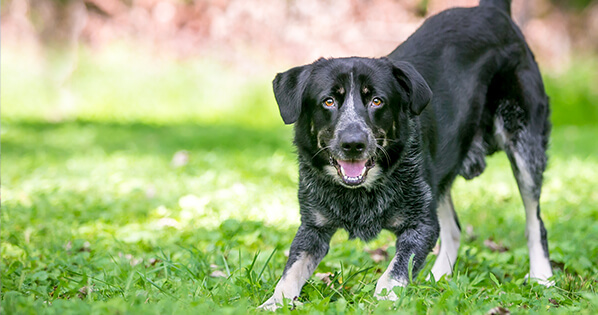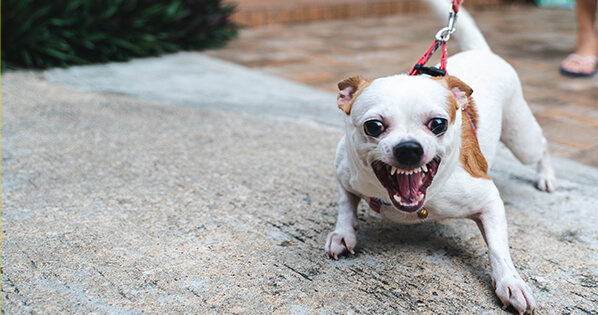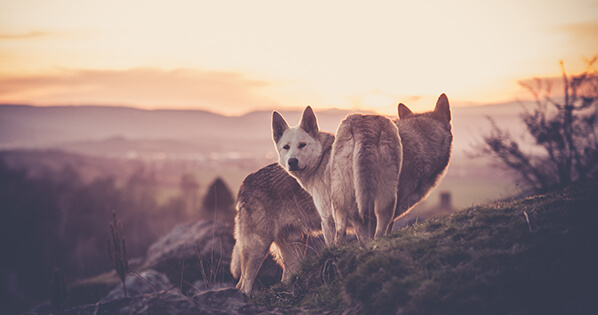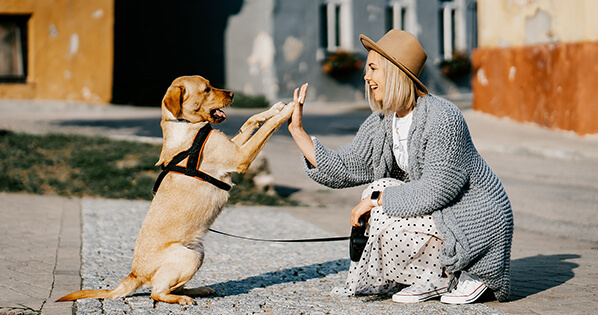
While humans primarily use words to communicate, dogs use energy to communicate, expressing it through body language. In order to effectively communicate with our dogs and be good leaders, we need to learn how to read and communicate with their language, rather than expecting them to learn ours.
One way to learn how to speak their body language is by remembering that:
energy = emotion + intention.
A dog’s “energy” is essentially intention and emotion working together in order to communicate with other dogs and humans. The better you are able to read and interpret these signs, the more you will be able to communicate and understand your dog, as well as others. This can help strengthen your relationship and pick up signs you may have never noticed before.
Cesar Milan has a great description to help understand how to interpret emotion + intention together in order to understand the animal’s energy:
Let’s consider a dog’s ‘play bow’ to another dog to illustrate how this works. The motion is forward, but the front of the dog’s body is low to the ground. The intention (the forward movement) is excitement but the emotion (the low body) is friendly, so the energy is playful.
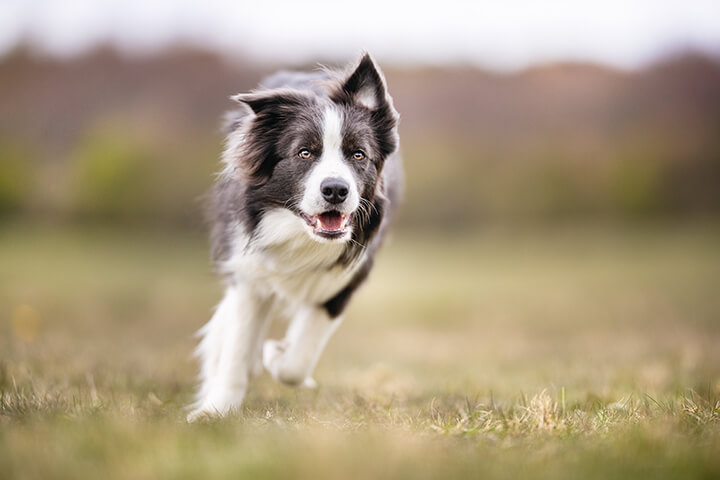
That means that similar behaviors can mean different things. For example, a happily excited dog and an aggressive dog may both move forward toward a person or other animal, but one of them is playful and the other one is threatening. Likewise, a dog may run away in fear or it may run away to start a game of chase with another dog.
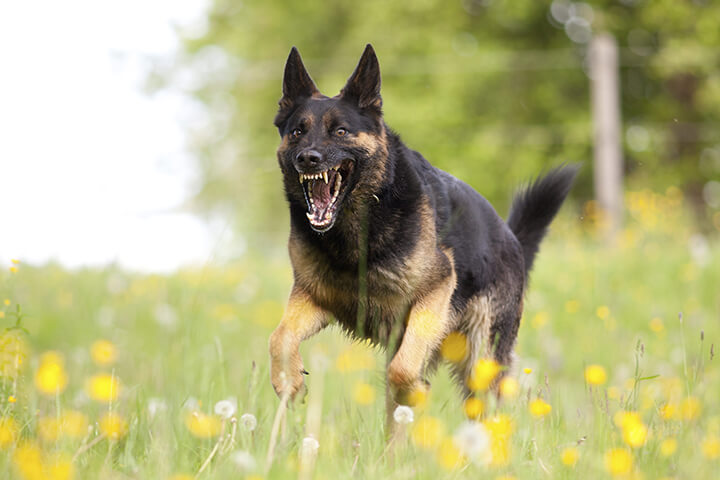
The important parts to watch are the head, ears, tail, and back. The higher these are, the more dominant a dog is feeling, and the lower they are, the more submissive or uncertain her feelings. Look also for tension in the dog’s body, particularly in the back and legs. The more tense a dog is, the higher its energy level.
It can be easy to misinterpret a dog’s energy, so it is important to develop a habit of close observation of their body language to read and interpret how they interact with humans and other dogs. For example, many people are afraid when a dog shows its teeth, but an astute observer knows that when the teeth are together, with the ears pulled back along the head, eyes squinting, and the body is lowered and leaning away, the dog is actually showing submission. Likewise, a dog may come charging at you, but if its body is relaxed, its tail is level and wagging, and there’s no tension in the body, then it is showing excitement, not aggression.
Dogs can’t tell us in words what they’re thinking and feeling because they don’t have to. They’re expressing themselves constantly through their body language. Once we learn how to understand this, a whole world of communication with our dogs opens up.
Reading Isolated Body Language Indicators
Let’s talk about the core 5 body language indicators on a dog to give you a better idea of where you should be focusing on when observing:
1
Eyes
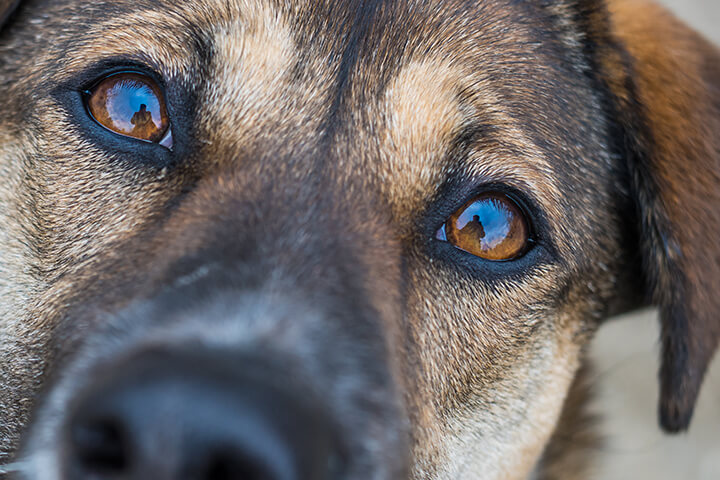
When looking at dog’s eyes, pay attention to the white part of the eye (the sclera), and consider the focus and intensity of the dog’s gaze. When a dog is feeling tense, his eyes may appear rounder than normal, or they may show a lot of white around the outside (sometimes known as a “whale eye”).
Dilated pupils can also be a sign of fear or arousal—these can make the eyes look “glassy,” indicating that a dog is feeling threatened, stressed or frightened.
A relaxed dog will often squint, so that his eyes become almond-shaped with no white showing at all.
2
Mouth

A relaxed dog will likely have his mouth open and may be panting, with no facial or mouth tension. The corners of his mouth may be turned upward slightly.
A fearful or tense dog will generally keep his mouth closed, and may pull his lips back at the corners (also known as a “long lip”.) He may also be panting rapidly. A panting dog who suddenly closes his mouth in response to something in the environment may also be indicating increased stress. Drooling when no food is present can also be a sign of extreme fear or stress.
A dog displaying a physical warning may wrinkle the top of his muzzle, often next pulling his lips up vertically to display his front teeth. this behavior, called an “offensive snarl,” which could be interpreted as in various ways depending on the other indicators. An “offensive snarl” is a muzzle that is wrinkled with the corner of the mouth looking short and forming a C-shape. This warning often comes with a tense forehead, hard eyes (usually with round eyes, a lot of white showing, and a fully dilated pupil.) This dog also may exhibit growling or barking as well, which are all very clear warning signs or their energy.

Some dogs display a “submissive grin” or “smile”. This is also a gesture where a dog shows his front teeth, but a smiling dog is doing just that. He usually shows a lowered head, wagging tail, flattened ears, a soft body posture and soft, squinty eyes along with those teeth. Teeth don’t always mean aggression—it is important to consider the whole body and the context to understand what a dog is saying.
3
Ears
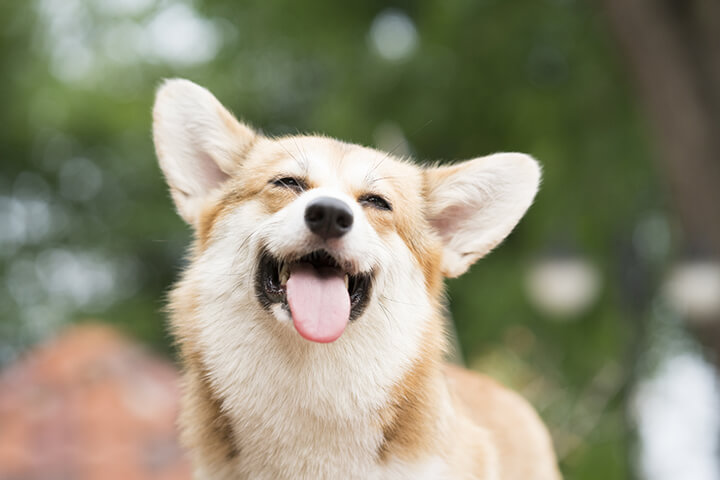
Dogs have a wide variety of ear types. Although it may be easier for us to see ear position in dogs with erect ears, even floppy-eared dogs like Basset hounds can move the base of their ears forward and back to show different emotions—just look at the direction of the base of the ear. When a dog is relaxed, his ears may be slightly back or out to the sides. As a dog becomes more aroused, the ears will move forward, pointing toward a subject of interest. When their ears are most forward their foreheads often wrinkle.
4
Tail

When observing a dog’s tail, there are two things to consider: the position of the base of the tail, and how the tail is moving.
A relaxed dog holds his tail in a neutral position, extending out from the spine, or maybe below spine level. As the dog becomes more excited or aroused, his tail usually rises above spine level.
The tail movement may be a loose wag from side to side or a sweeping circular motion. He may also move his tail side to side in short, rapid movements as he becomes more excited.
A fearful dog will tuck his tail between his rear legs. The tail may also be held rigid against the belly, or wag stiffly.
5
Hair
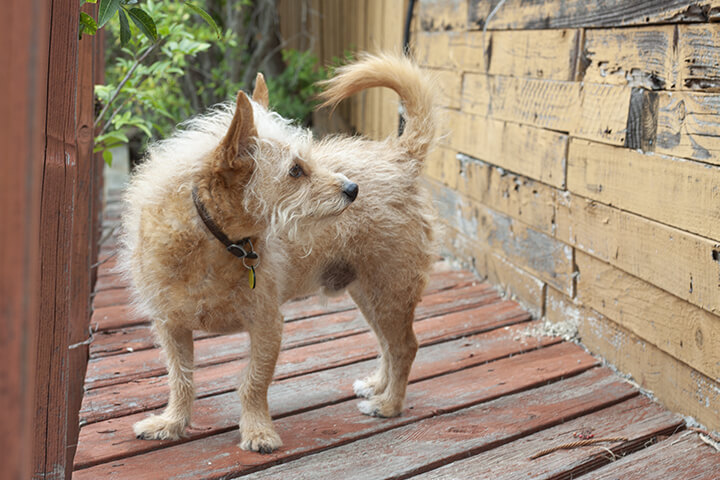
Much like your own “goose bumps,” the hair can raise along a dog’s back when he is upset or aroused. This is also known as piloerection or “raised hackles” and can occur across the shoulders, down the spine, and above the tail. Hackles don’t always mean aggression is imminent, but they are an indicator that the dog is excited or upset about something.
A frightened or stressed dog may also shed more than usual.
Putting It All Together
Now that you understand how intention and emotion work together to create specific body language indicators, lets talk about the 8 most common body positions you will see when interacting with dogs:
1
Relaxed Approachable
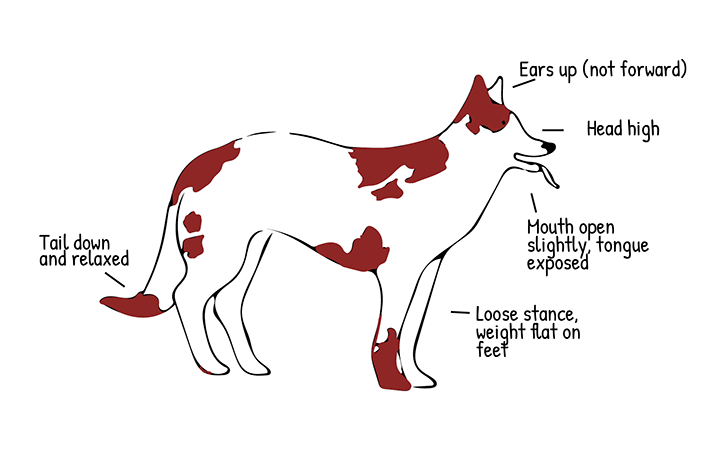
A dog with a loose tail, mouth, and stance, and an upright (but not stiff) head and ears is relaxed and overall comfortable. This dog feels untroubled and unthreatened by the activities going on in their current environment, and will usually welcome being approached. However, always approach new dogs with caution. Do not rush into a greeting or reach out your hand too quickly, even if the dog seems relaxed and approachable.
2
Alert- Checking Things Out
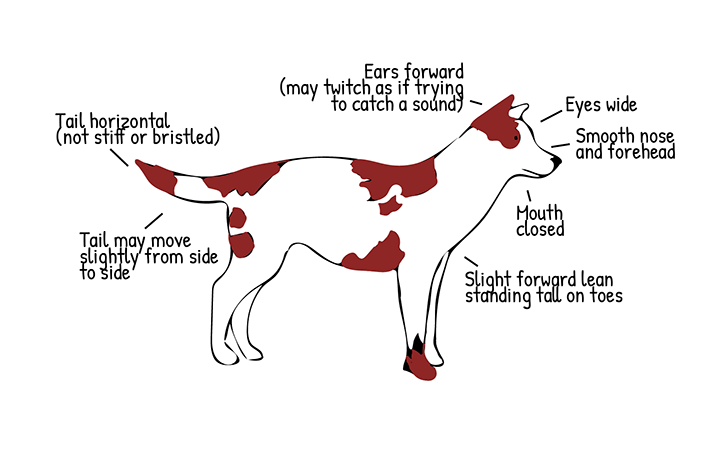
When the dog’s tail, stance, ears, and mouth are all slightly engaged, this is a sign that they are alert and checking something out. When the dog detects something interesting or unknown, these signals show that she is alert, attentive, and assessing the situation to determine if they are in danger or if they need to take any action. To break their fixation and gaze, using the “easy” command or redirecting their gaze may help your dog to refocus on you.
3
Dominant Agressive

A dog with a highly engaged and tense tail, stance, ears, mouth, and fur is displaying dominance and confidence. In addition to showing their social dominance, this dog is also threatening that they will act aggressively if challenged. Understanding this behavior and knowing whether your dog is dominant or submissive can help strengthen the relationship with your dog, and help you be more aware of how other dogs around you may respond.
4
Fearful and Aggressive
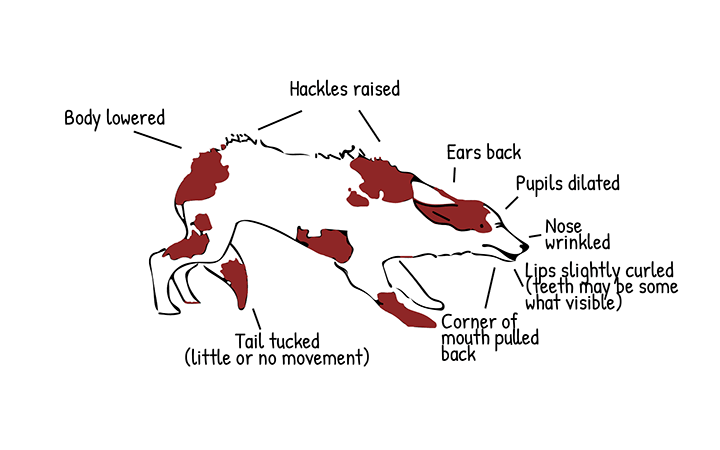
A dog that appears tense across the legs, tail and mouth, but with a lowered body and head, is showing that they are frightened but not submissive and may attack if pressed. A dog will often show these signals when they are directly facing the other dog or animal who is threatening them. It can be difficult to interpret or predict how a fearful dog may react, so it is generally a good idea to proceed with caution and calm the dog down with your voice and energy.
5
Stressed and Distressed
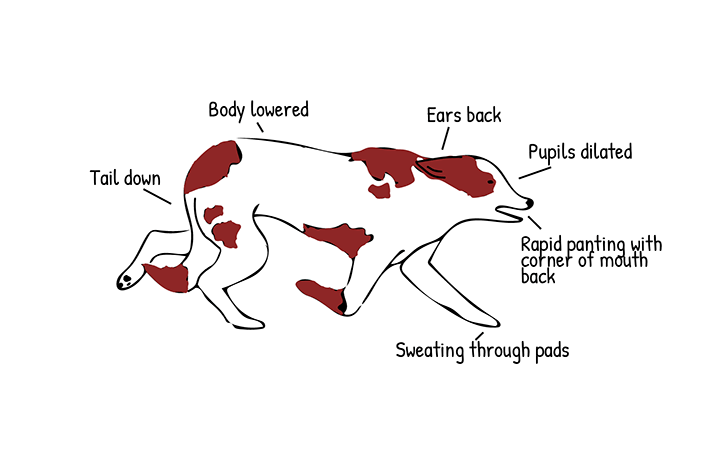
A dog with a slumped body, tail, stance, and ears is showing that they feel stressed and distressed about their environment or the other dogs and animals around them. These signals are a general sign of how they are feeling in the moment, but are not specifically directed at any dog or stimulus in particular. This is often seen in puppies and young dogs who are getting used to new environments like the dog park, car, new play groups, etc.
6
Fearful and Worried
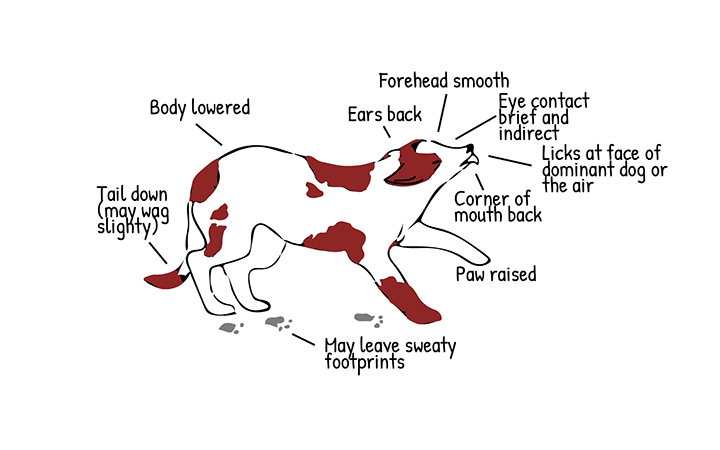
A dog showing a slumped body, but with their head raised and licking the air is feeling somewhat fearful or worried, and offering submission to another dog. These signals are meant to appease a dog who is of higher social status or potentially threatening, in order to avoid any conflict or confrontations. If your dog frequently shows this body language, he or she may not feel comfortable in their environment and you may need to remove them from that place to get them to calm down.
7
Extreme Fear- Total Submission
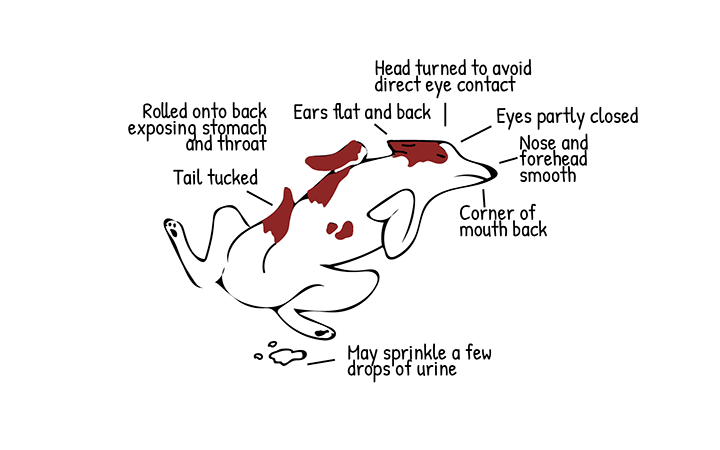
A dog on their back with their tail tucked and head turned away is showing total surrender and submission. He or she is trying to say that they accept their lower status by pleading to a dog who is of higher social status or potentially threatening, hoping to avoid conflict or confrontation.
8
Playful
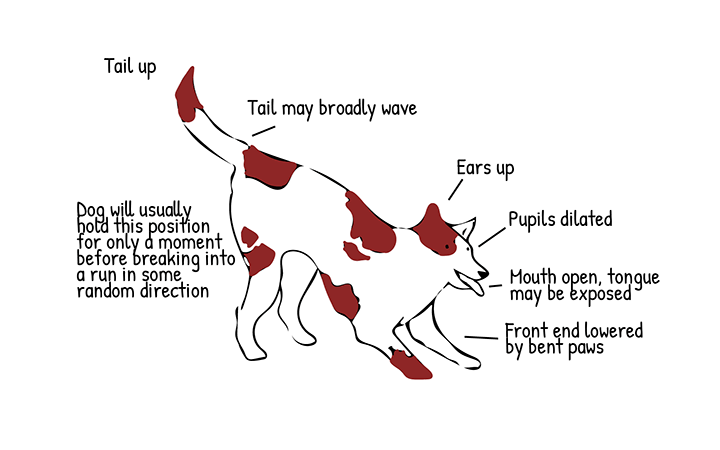
A dog “bowing”, with their tail up and an open mouth is showing the classical play bow. This body language may be accompanied by excitement, barking, or running playfully to attack and retreat. These signals may also be used to make it clear that any previous rough behavior was not intended as a threat or challenge.
Being able to read and interpret your dog’s body language is crucial to building a strong and lasting relationship with them. Just like humans, our furry friends use non-verbal body signals constantly to communicate with the world around them. The better you are able to interpret these signs, the better you will be able to know exactly what your dog is thinking and feeling in any situation. This can help avoid negative interactions, fights, stress, and overstimulation simply by becoming a keen observing of the non-verbal language of your dog.
To learn more about other ways to increase your bond with your dog, check out Lesson 1, Lesson 2, and our relationship-based training guide. If you want to learn more, feel free to book a free behavior assessment and come chat with us!

